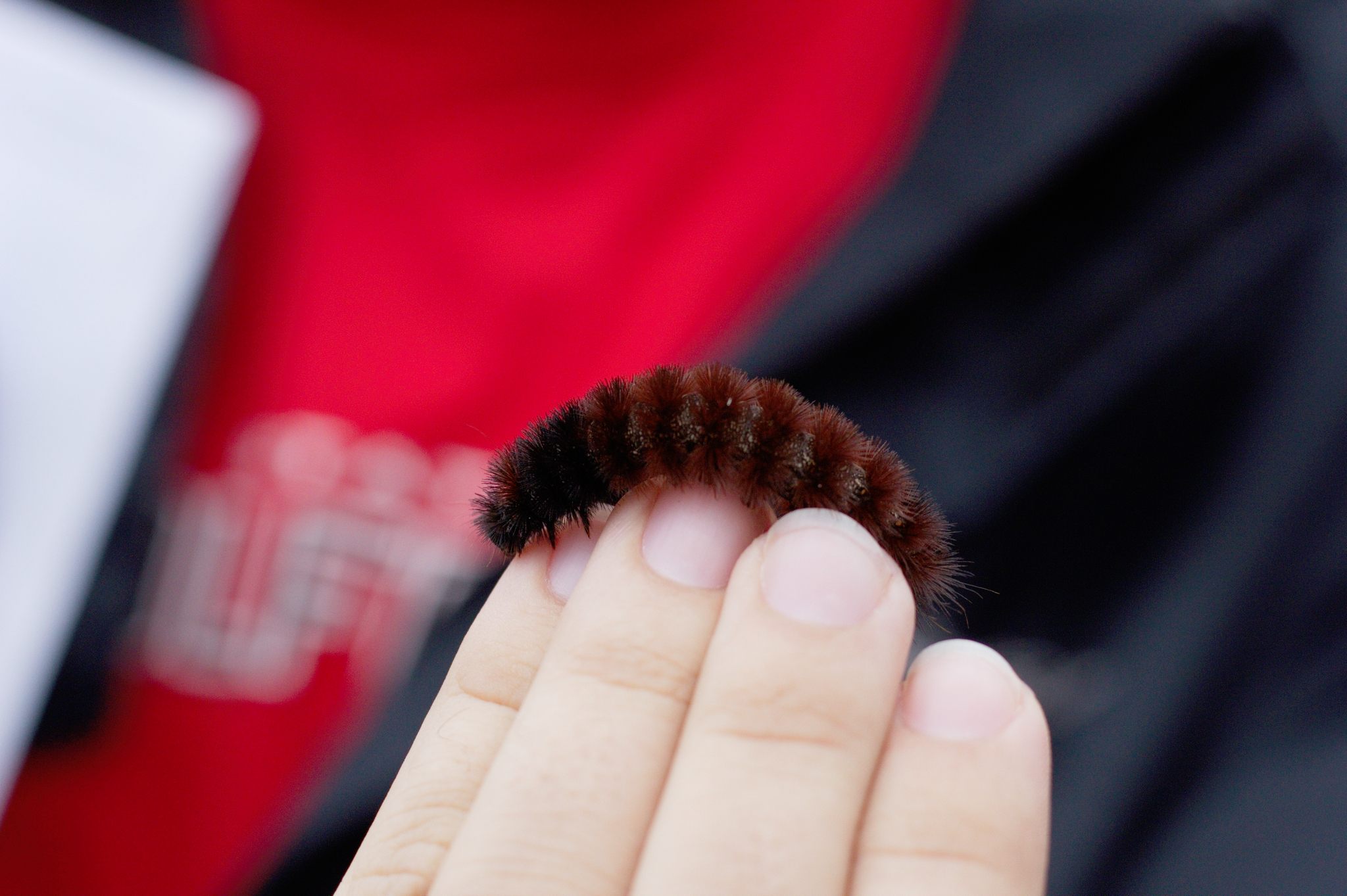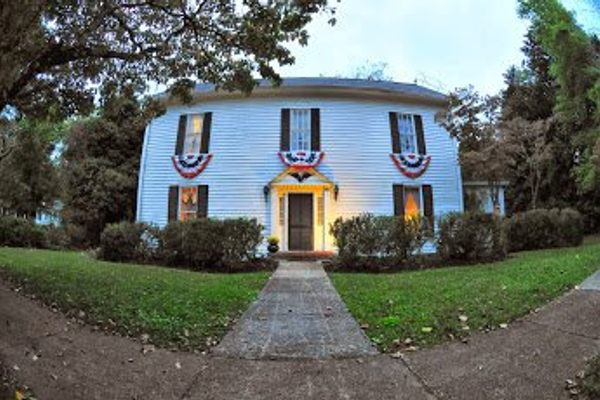A Visit to the Foremost Annual Festival for Weather-Predicting Caterpillars
Woolly worms may not be the greatest meteorologists, but they sure are entertaining.

On a cold and drizzly Saturday morning in October, several thousand cars are snaking their way through North Carolina’s winding mountain roads into the town of Banner Elk, a tiny and prosperous village nestled between two ski resorts. Upon first glance, the annual event that draws these visitors looks much like any other outdoor, family-friendly festival this time of year in the American South: kids getting their faces painted; vendors selling quilts, beeswax candles, and muscadine cider; trucks slinging gyros, funnel cakes, and something called “steak-in-a-sac” to hungry people swathed in camo and fleece. But the dozens of families huddled on the hay bales fanned out in front of the rickety yellow main stage are here for a very specific reason (and it isn’t the Elvis impersonator singing “Sweet Caroline”). They’re here to watch the worms race.
On the stage, which is bedecked with cartoonish illustrations of a fuzzy, grub-like character in running shoes and a sweatband, people of all ages—a middle-aged couple, a toddler tip-toeing on a foot stool, a college kid from Durham—are huddled around their respective “lanes,” a three-foot length of vertical string crested with paper name tags bearing honorifics like Dale Wormhardt, Wormy Daniels, and Willy the Wonder Worm. Competitors carefully place their athletes on the string before them and, when the emcee gives his “ready, set, go,” they step back. And it’s off to the races.

Some of the caterpillars inch their way skyward; others refuse to move and loiter in their lanes; a couple of particularly apathetic specimens give up entirely, let go, and drop to the ground. (One child begins to sob when this happens and his caterpillar is lost underfoot; the emcee hastily comforts him and directs him to the “corral,” a bucket at the end of the stage functioning as stash of backup worms.) A few people use plastic drinking straws to blow air on the bugs and, presumably, encourage them to move faster. Every handler claps and cheers for their racers, as do the spectators down on the hay bales, even though from their vantage point it mostly just looks like a stage full of fake mustaches dangling from string like tiny marionettes. In this particular heat, “Eastbound and Down” by Jerry Reed is blaring over the speakers. As the 25 fuzzy dark caterpillars, each approximately the size and shape of a single bushy eyebrow, crawl their way toward the heavens, the lyrics ring particularly true: “We’ve got a long way to go, and a short time to get there.”
This is the Woolly Worm Festival, an event centered entirely around the larvae of Pyrrharctia isabella—also known as the isabella tiger moth, or the woolly bear—and a cultural legend that humans have projected upon the insects for centuries. Folk wisdom, the kind that colored Appalachian culture and practices for centuries (and to some extent, still does), dictates that the woolly worm caterpillar can be used to predict the weather of the following winter, based on the coloration of the black and brown bands on its body: a worm banded in mostly black portends a grim, harsh winter; one sporting more brown foreshadows milder temperatures and conditions.

Other Woolly Worm festivals exist: Beattyville, Kentucky and Vermilion, Ohio each host their own versions of the event. But here in Banner Elk, a ski town, winter weather carries particular economic significance—and now, the event itself does, too. The festival has hosted tens of thousands of visitors and, according to the Mountain Times, generated an estimated $1.4 million in its 40 years. For Banner Elk and the surrounding Avery County, the worm isn’t just an auger of a prosperous ski season to come: it’s a scrap of old mountain folklore made lucrative.
For the rest of the day, the old yellow stage functions as a revolving door for more than a thousand worms competing in seventy-some heats until the quarter finals, the semi finals, and the finals, whose victor is honored as the official winter weather forecaster of Banner Elk. This year’s ultimate winner, named Montgomery County’s Best, predicted for Banner Elk three weeks of below-average temperatures, one week of frost or light snow, six weeks of above-average temperatures, and three weeks of frost or light snow, in that order. (Perhaps more importantly, its owner, Carolyn Thompson, walked away with $1,000 in prize money.)
Jason DeWitt, who teaches skiing lessons at the nearby Beech Mountain during the winter, is scurrying around the stage, wearing a baseball cap festooned in faux caterpillars and a canvas jacket emblazoned with “The Woolly Worm Dude” on the back. “Back before they had meteorology, the farmers up here wanted to get a heads-up on the winter,” he tells me. “They found out years ago, when they looked at a woolly worm, it either has a black body segment or a brown body segment. So they read the worm.” DeWitt acts as a stage administrator for the event; it’s his 27th year of participating. “Winter is very important to us here,” he explains, pointing out the nearby ski slopes encircling the town. They’re barely visible through the fog.

Humans have tried for centuries to guess at the weather, and the woolly worm as winter weather oracle is just one of many time-honored methods. The woolly worm isn’t the only insect saddled with this duty: Foxfire Magazine, the quarterly journal out of north Georgia that covered traditions and practices in Appalachian culture, listed out a dozen other insect prognosticators in a 1970 article, “It Will Be A Hard Winter If.” In addition to the omens on a caterpillar’s body, it says, one can also determine the coming winter’s severity if “there are a lot of crickets in the chimney” and that “three months after the first katydid begins hollerin’, the first killing frost will come.” Attention is also paid to the height of anthills, the migration patterns of butterflies, and the behavior of miller moths.
Even here at the festival, I’m told of other strategies that the old-timers in these mountains swear by: place a bean in a jar for every foggy day in April, and you’ll know exactly how many snow days the following winter will bring. Look for whether bees are building their hives close to the ground or high in the treetops. Melynda Pepple, director of Avery County’s Chamber of Commerce, tells me one of the event’s vendors, a stone carver, even has special rocks that he swears change color before the rain. “Why not?” she says. “I mean, I had a weather poodle growing up.”
It is of little concern to any of the worm’s acolytes, in Banner Elk or elsewhere, that the meteorological qualities of the caterpillar have been mostly debunked.
In 1948, American Museum of Natural History curator of entomology Dr. Howard Curran embarked on an eight-year “study” at New York’s Bear Mountain to find whether there was any correlation between the bands of the caterpillars and the severity of the following winter. Curran’s research was primarily focused on flies (he discovered more than 2,600 species of them over the course of his career), but the woolly bear, and the lore surrounding it, captured the scientist’s curiosity. Dr. David Grimaldi, one of Curran’s successors at the museum, describes the project as “fun science.” By that point in his career, Grimaldi says, Curran had taken up a number of side projects rooted in entomological science, from writing articles to working on exhibitions. “He certainly seems to have taken the woolly bear thing seriously, applying a bit of scientific rigor to a popular tale,” Grimaldi says. “Perhaps he realized that popular legends die hard, and the only way to dispel them was through detailed scientific observation.”

Curran reported his annual findings to the New York Herald Tribune, which published the results each fall. In 1949’s installment, Herald Tribune reporter John O’Reilly rode along with Curran on his October expedition and, in a mock-serious account, detailed the scientist’s methods for hunting and capturing “a goodly number of bears” while driving along the roads around Bear Mountain. That year, O’Reilly reported, Curran collected a sample size of 23 caterpillars and calculated, based on the total number of brown segments divided by the total number of specimens, that the following winter would be even milder than the last. (According to historical weather data, the next January at Bear Mountain brought average temperatures of 34 degrees — precisely one degree warmer than the previous year’s January averages.)
Over the years of this annual reportage, word of Curran’s experiments spread. A tongue-in-cheek column in The Old Farmer’s Almanac in 1962, responding to complaints of unethical meteorological “quackery” from the American Meteorological Society, jokes: “Recently, the Woolly Bears, championed by Dr. C. H. Curran of the American Museum of Natural History … threatened to move in and take over the whole long-range forecasting field, including the venerable United States Weather Bureau.” (As recently as 1998, the Almanac reiterated the worm’s legend in its pages. A quick glance at the comments on this updated web version of the story reveals that the insect still holds a lot of significance for people.)

The Museum’s archives hold roughly 200 letters to Curran from people inquiring about the veracity of the caterpillar’s claims, along with his responses, which kindly but firmly controvert the myth. To one Robert Dice of Curry, New York, he writes in 1949, “Your great-grandfather’s interpretation of the meaning of the bands on the caterpillar is similar to that which I have always heard. I am afraid I am slightly dubious about the accuracy of the animal’s forecasting.” In another from November of 1950, Curran responds to a Massachusetts woman inquiring about whether the woolly bear legend was true, and if so, whether she should start a building project that winter, based on the previous year’s mild forecast. “Scientists really do not believe that they can do so,” he writes. “The Woolly Bears have predicted a warm winter, but I should not like to depend upon them to make a decision about building a house immediately.” And in response to an MIT meteorologist asking for details of the study in 1952, it’s clear that Curran’s research was more hobby than rigid academic endeavor: “Since we did not take this thing seriously, we see no reason to keep the detailed accounts.”
Incidentally, Grimaldi points out, the public seemed to latch on to Curran’s research in a way he couldn’t have predicted. “I think Curran would be surprised today to see how often his name is attributed to support of the woolly bear band width tale, when in fact he debunked it,” he says. But, he adds, “if Curran were living right now, he would also be surprised by the number of people willfully ignorant about science — creationists, flat-earthers, anti-climate science, you name it. So I don’t think the great woolly bear controversy would necessarily get him too worked up.”
Given that sentiment, it’s ironic and a little bit heartbreaking to read Curran’s perspective on that 1949 prediction of another mild weather, reported in the Herald-Tribune: “It doesn’t seem possible,” he tells O’Reilly. “If this winter is milder than last, palm trees will be growing in these parts.” He wasn’t entirely wrong.
But here in Avery County, the worm’s lack of scientific credentials doesn’t seem to bother anyone. When I ask a handful of festival-goers whether they really, truly believe in the worm’s prognosticating power, few hesitate to affirm that they do, and several people mention a figure once provided by Appalachian State University: “It’s 85 percent accurate.” (In November 1975, Appalachian State’s student newspaper, The Appalachian, reported that students of the university’s entomology and meteorology departments assembled a “Center for Woolly Worm Study” to compare woolly worms of Western North Carolina with the region’s climatological data, though it’s unclear how long the project lasted or how they arrived at that particular figure.) The festival draws thousands of visitors to the town, generates roughly $50,000 in revenue each year, and makes people happy. The scientific accuracy of the claim upon which the entire event is premised? That’s not really the point.

At the Woolly Worm Festival, an idea that began as an homage to a piece of Appalachian folk wisdom has grown into a nexus of commerce for the town. “I don’t know if you know this, but you can’t find a motel room or B&B here this week,” DeWitt tells me. (It’s true—I had to spend the night at a motel the next state over in Johnson City, Tennessee, roughly an hour’s drive from Banner Elk.) “It’s a real shot in the arm.”
And indeed, in Avery County, a miniature economy has sprung up around the worm. In addition to the potters, hiking stick carvers, quilters, and slingshot crafters who sell their wares at the event, there’s also the Strickland family. Nan Strickland and her two granddaughters helm a booth a few hundred feet from the stage, where they peddle their own wild-caught worms, along with various worm-themed souvenirs, from tubs strewn with roughage. (You can also purchase a special plastic carrier for your specimen, though many elect to walk around cupping the worms in their hands or perched on their shoulders.) Nan tells me that their family spends the weeks preceding the event traversing mountain backroads in the sunny hours between 11 a.m. and 2 p.m. collecting the caterpillars—“they come out more in the sunlight,” she explains. The family sells them for $2 apiece at the event. This year, they brought 254 worms; in years past, their arsenal has numbered closer to four or five hundred. They sell out every year (and during one particularly fruitful festival a few years ago, they left midday to hurriedly replenish their stock). Science may not lend credence to the woolly worm myth, but you can’t argue with that math.

Over to the left of the stage, Dr. William Burrough presides over the official woolly worm first-aid station. Scattered in front of him is a full hospital’s worth of equipment in miniature: a defibrillator, X-ray machine, and MRI, all dollhouse-sized and scattered with faux caterpillars (and a few real ones) in situ. Burrough is a dentist from nearby Ashboro with a practice in Banner Elk and an old-school Southern accent. He is here to provide medical advice to kids concerned about their caterpillar’s health, as well as “certify” that the final race’s winner hasn’t benefited from performance-enhancing drugs. (The festival introduced this policy in 1988.) His loupes, which he uses to examine the worms, rest on the table nearby. I ask him whether, as someone formally trained in the sciences, he believes in the lore behind the worm. “I’ve got a lot of background in biochemistry, but to be honest with you, I’d have to say … it’s like faith,” he tells me in his slow, Southern drawl. “You just have to believe.”
















Follow us on Twitter to get the latest on the world's hidden wonders.
Like us on Facebook to get the latest on the world's hidden wonders.
Follow us on Twitter Like us on Facebook